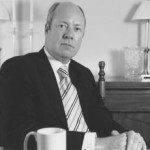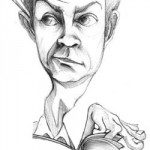After Honderich
Giles Gherson stands in the middle of the sprawling and bustling Toronto Star newsroom. He’s waiting for a photographer from his former paper, The Globe and Mail, to take his picture. It’s early October and Gherson finds himself in the rather uncomfortable position of making the news, rather than being among the legions who write and edit it. Weeks earlier he’d been the surprise choice to replace John Honderich as newsroom leader – his appointment one more signal that major change is reshaping both the business and editorial sides of Canada’s biggest daily. Now, just a few days into the job, he’s staring into a camera lens and looking, as one Star editor would later say, “lost.”
No wonder. The 48-year-old Gherson has a huge task ahead of him: to rethink how the paper packages and presents information in the “new world” of newspaper publishing. It’s an era when, for the first time in decades, advertisers can buy their way around the Star and readers can get their news elsewhere – not just from the Globe, Toronto Sun, andNational Post, but also from other information sources. Taken together, the variety of offerings – including freebie commuter papers, online news sites, and 24-hour cable-news networks – represent a significant threat to the Star. “The world around us is really shifting,” says Gherson, “and we have to respond to it in a vigorous way. Standing still isn’t an option.”
Since accepting the position, Gherson has no doubt received plenty of advice about what moves to make in any number of key areas, including how to re-energize a newsroom that, to be diplomatic, many see as lethargic and lacking drive. Even Dan Smith, the Star‘s book editor and newsroom union representative, is calling for a shake-up: “The culture here needs to be eradicated, blown up, destroyed,” he says. “It’s dysfunctional.”
But because his union has done such a good job of protecting employees (and negotiating high salaries), Gherson can hardly go about the mass firing that some feel the place needs in order to get rid of reporters and editors who have grown way too comfortable. Instead, the outsider has chosen to follow a less revolutionary path. He’s out to win their confidence, their trust. If the Star is to successfully retool – something Gherson thinks it must do – then he’ll have to help clear away the gloom that still lingers five months following Honderich’s sudden exit. As Star columnist Rosie DiManno noted, “We’ve done a lot of bleeding around here in the last year.”
Gherson recognizes the motivational challenge. “You can’t impose a culture on a place,” he explains, “because it’s already got a strong culture. But what I want is a culture where people accept change more readily and appreciate the battle we’re in.”
Gherson first started competitive running as an English schoolboy. Just last fall, he finished a half marathon in under two hours. He’s learned the value of pacing himself: breathe deeply, keep your eyes on the road ahead, don’t start off too fast. His patience was important in the first few weeks. He shared the reins with Honderich’s No. 2, Mary Deanne Shears, who also applied to be the new editor-in-chief. When Shears stood square-shouldered alongside Gherson as they jointly conducted a blitz of meetings, from sports to photo, editors didn’t know whether to look at the yellow-haired Shears or the dark-featured newcomer. “People would studiously look at a point exactly equidistant, but slightly higher, between the two of them,” says Smith. “It was very weird for a couple of months. Everybody knew she was dead, but she was acting as if she was never going away.”
She did, though, in January, ending her seven-year stretch as managing editor at the Star. “You cannot have a campaign that tries to undo what you think are the dysfunctional shortcomings of the prior regime and leave, as your No. 2, one of the primary architects of that dysfunction,” Smith says.
Even with Shears gone, Gherson kept to a steady pace. “It’s the early days,” he explained at the time. “I would expect there to be some confusion and some uncertainty about exactly what’s going on. I’m learning from the people around me as to what works, what doesn’t work, what the right messages are. It’s a question of everybody getting on the same page – me, too.”
But he does know the right questions to ask, which no doubt impressed the Torstar brain trust that hired him. “As a major player in this industry,” says Gherson, “we have to be thinking: Where are we going to be in five years time? What’s the Star even going to look like? Is there even going to be a newspaper? Are we going to be online and, if so, how are we going to prepare for that day?”
In his 26-year career, Gherson has been a top business reporter, political columnist, and the editor of a major metropolitan daily. As well, he spent time in Ottawa as a policy wonk under Lloyd Axworthy, one of the most liberal Liberals – a handy association for someone running a newspaper built on the reformist ideals of the Atkinson principles.
In his long and impressive run to the Star, he’s barely stopped for a breather. He first entered the business after graduating from Queen’s University in 1979 (with honours in history and political studies) by landing a gig at The Financial Post. Working at a weekly paper that covered many of the same stories as the dailies, Gherson learned how to “enrich” news stories, how to push them further in both detail and analysis. (Gherson met his longtime buddy and adversary Edward Greenspon at FP.)
In the mid 1980s, FP executive editor Dalton Robertson promoted Gherson to the bureau in Washington, D.C. “He was very hardworking, very bright, and very mature,” recalls Robertson. “He was a stand-out reporter in the newsroom, but he wasn’t boastful.” Gherson took the position so seriously that other reporters had to pound on his door at night to tell him to go home to his wife and two daughters, Pippa and Nicola. (Gherson’s marriage later broke up, allowing female Star staff to fire off emails before his arrival, gossiping about his availability.)
Ian Austen, now a writer for The New York Times, worked in Washington for Maclean’s at the time. He recalls the many nights he would leave his office and hear Gherson – who has a self-confessed reputation for “tinkering with the fourth graph of the sixth story” – still banging away on his keyboard. “He’s extremely smart,” Austen says, “but he’s a terrible workaholic.”
From the Financial Post, Gherson went on to write on national affairs for the Financial Times, the Globe, and later, as Southam News editor for the National Post. Gherson enjoys analyzing complicated political issues and decoding them for readers. “I tried very hard not to be ideological,” says Gherson. “I tried to be pragmatic.” But through his journalistic experiences and what he learned during a 1994 to 1996 stint as principal secretary to Axworthy, he developed some strong ideas about government. (Gherson helped the then minister of human resources development overhaul unemployment insurance legislation.) “I’m quite harsh on governments who appear to be spinning their wheels or enjoying life and not really creating any an agenda,” he says, “I like change.”
Gherson saw a slew of change as the editor-in-chief of the Edmonton Journal. In the late ’90s, while visiting newsrooms across the country as editor of Southam News, he decided he’d enjoy the challenge of running a daily. “I was attracted to Edmonton because it was a really vibrant community,” Gherson says. “It’s got a big oil patch but there’s also a large blue-collar workforce. At the same time there’s a huge arts community and a big folk festival, and it also has a university so you’ve got a lot of scientific and technological innovation.”
The passion and curiosity Gherson brought to the Journal made him “a breath of fresh air,” says Allan Mayer, the deputy editor at the Journal who took over after Gherson left in early 2004. “He was like a kid in the candy shop – the editor of this paper in a pretty interesting community. He found out everything he could about what was going on here.”
Gherson introduced the Economic Outlook Series, which appeared periodically and focused on business and industrial growth in different parts of the province. He says the sections jump-started the Journal‘s agenda to engage those living outside of the city. “You can’t just dip in and out every so often. It took us years to build up a relationship with the suburbs.” As well as implementing a redesign, Gherson also invented ed, a special insert for young readers. Mayer remembers his boss “asking tough questions. He was big on context, and wouldn’t let some stories pass if they just stood in isolation. He’d say, ‘Let’s get other people to comment on this and turn it into a bigger story.'”
Mayer wasn’t at all surprised at Gherson’s decision to accept, in early 2004, the editorship of the Globe‘s Report on Business (ROB) section. “He moves around quite a bit. He finds it invigorating, and that’s the way he’s been for years.”
At the Globe, Gherson was reunited with Greenspon, who had been named editor in 2002. “When you demonstrate your intellectual chops with some of the very senior folks in Ottawa, especially around the finance department,” explains Colin MacKenzie, a managing editor at the Globe, “they love to have someone who can run with them. Both Eddie and Giles were able to do that.”
Even though his ROB tenure lasted just eight months, Gherson made many improvements, such as redesigning the Saturday edition by making room for more in-depth stories. He launched the “2 to Watch” page, which profiled two innovative Canadian companies. He also oversaw an award-winning series on mutual funds. His vision for ROB tended to mirror Greenspon’s. Their backgrounds aren’t that different, and they have similar management styles. “He’s pretty collaborative, and I believe I am too,” Gherson says. “He’s got a strong vision for his paper, and I do too.”
Naturally then, Greenspon says he’d prefer to have Gherson on his side than against him. The Globe editor got his friend’s call about the Star‘s offer while driving home from a canoe trip. “We were just getting started,” recalls Greenspon, before joking, “I don’t know what counter-offer I could have made – aside from offering him my position.”
Greenspon can joke about it, but Gherson is always serious, intent, on message. “I want the paper to look energetic and have passion,” he says during an interview three months into the job. “If you look at the front page, I want us to be able to say that these stories are ours. That takes work, so a lot of one’s day is spent talking to reporters, talking to editors as a group, about how we’re moving forward on stories.”
Still, Gherson makes it clear he respects the paper’s traditional strengths: “The last thing you want here is to lose people who have an institutional memory,” he says. “What you really want is for the people with that institutional memory to adapt to the changing circumstances.” Gherson espouses the previous regime’s goals: moving into the farther reaches of the Greater Toronto Area, and further incorporating younger readers and ethnic communities. Otherwise, he says, “We’re going to face stagnant or declining readership.”
He also backs the new workflow structure, which was first proposed a year ago with the idea of revolutionizing the way copy moves through production. Before, copy passed from various assignment, deputy, copy, and section editors without much collaboration in between. Also, editors typically wouldn’t offer feedback on stories until around the 5 P.M. deadline. Now, one handling editor tracks a team of about six reporters throughout the day and works more closely with other editors and the page designer. The reporter teams are now arranged thematically, in addition to the traditional categories: national, provincial, and city. “Everybody I’ve talked to has pretty much agreed that over the years it got large, unstructured, unwieldy, unresponsive, and not necessarily a great place to work,” explains Gherson. “And too stove-piped – ‘I’m on the business side,’ ‘I’m on the city side.’ You don’t get that sense of esprit de corps that you need in a newsroom.”
The Star‘s newly appointed photo editor, Ken Faught, likes what he’s seen so far. “There’s more openness to ideas about what we do. There’s more autonomy. It’s just been a huge improvement in terms of management style. He’s open to change.” Faught first realized he was working for a different leader when Gherson mentioned he didn’t want anyone to shoot a speaking engagement. “When I told the photographers they almost fell off their chairs,” Faught says. “The old Star would have made that front-page news, even if meant sacrificing other news.”
Another project Gherson inherited was the relaunch of the Sunday Star, which is now a magazine-style package with long features and powerful graphics. “Our hope is tinged with acknowledgement that longstanding newspaper readers inevitably lament changes as an annoying, unnecessary disruption,” Gherson wrote in an editorial. But, he added, “Newspapers’ survival depends on actively engaging readers intellectually and emotionally by giving them richer, value-added stories that provide context and meaning to the relentless daily barrage of information.”
As for his own initiatives, Gherson wants to make all stories Star stories. “At news meetings now, there’s more discussion and less list-reading,” Gherson says. “We’re not just saying, ‘Here’s what we got.’ We’re asking how can we make that our story? What can we do that’s different?” But, Gherson admits, “It takes time to imbue everyone with that approach.” (Gherson also moved the news meeting from 3:30 to 5:00 P.M., an efficiency-booster that many at the Star agree should have happened long ago. Before, editors picked lead stories based on guesswork, since, at 3:30 P.M., most copy hadn’t been turned in. Now, editors make decisions based on what’s actually in front of them.)
Another Gherson move has been to ape his rivals’ penchant for bolder, more sensationalist headlines – the latest front in the newspaper war. One of the first in Gherson’s reign concerned the appointment of two new Supreme Court judges: “They. Are. Women.” Other examples: A Sunday coverline exclaiming, “Why Canada hates Toronto,” accompanied by a pagefull of quotations including “arrogant,” “superior,” and “demanding”; a weekday headline about a man who threw his daughter from an overpass, which screamed “Don’t do it!” and, after the controversial acquittal in the Air India trial, this stats-laden attention-getter, “331 lives lost, 20 years gone… 0 murder convictions.”
In Gherson’s efforts to grab readers, he’s already created controversy. Shortly after the tsunami, the paper published a photo of an emergency worker spraying layers of bodies. Some thought it was in bad taste, but Gherson later went on CBC Radio to defend his decision to run the picture, saying that it was important to put the tragedy front and centre. “The tsunami got enormous coverage, but at a certain point there was a numbness. People were saying enough already, and we felt we had to engage them in a more visceral way.”
Gherson’s boldest decision was to publish a government-leaked list of names of Canadians who were presumed dead or missing. The outcry was immediate. Media outlets across the country ran emotional stories about how the inaccurate list affected families. “If 150 Canadians have gone missing – who knows how many from the Toronto area? That’s a big story. I feel absolutely fine about it. We want to be aggressive,” Gherson says. He also defended the coverage at a media panel, “News Gathering and Image Making: From Iraq to the Trial of Jacko,” telling the packed auditorium that it wasn’t fair that a few politicians in Ottawa could withhold such an important document, and that publishing the list allowed Canadians to aid the government in correcting it.
Gherson knows he still has stubborn Star staffers to bring on board, that they dwell in an environment Globecolumnist Margaret Wente once called “a Machiavellian kind of place with knives thrust in backs and fronts.” Still, he’s confident he can win them over. “They start experiencing [the new way] and it doesn’t change their lives too much,” he says. “Then it becomes something that really is enlightening, as opposed to something to be feared.”
The danger, of course, is that this go-getter will push change too rapidly. One editor talks of a time when Gherson mentioned that he thought Saturday stories were too long, and he’d like to see them at 40 inches instead of 60. The Saturday editor immediately started lopping off every single story, to the horror of the writers. Gherson didn’t realize his word would be taken so literally. “The Star is a big ship with a big crew,” says assistant city editor Greg Boyd Bell. “As editor-in-chief, if you say something, it’s the law.”
Gherson, however, doesn’t seem deterred by such muck-ups. To explain himself, the marathon runner uses another sports analogy: “It’s like diving into a pool – you know it’s going to be cold at first, but when you do jump in, it’s pretty exhilarating.”
Wendy Glauser was the Senior Editor for the Summer 2005 issue of the Ryerson Review of Journalism.












































